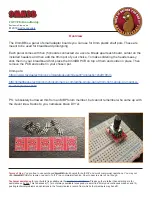
Doc.Ref.No.:mVMT/om/101
masibus
Issue No. :00
Model : VM908
Operator’s Manual VM-908 Vibration meter
Page 6 of 11
02/05/16
b.
Key release: Hold the measured value for twenty seconds and then power off automatically.
3). Stick the probe to the measured object (the pressure should be about
0.5-1 kg.)
5.
NOTES
1.
Avoid intense impact, high temperature and immersion in water.
2.
Keep the sensor plug clean and dry, and use it carefully.
3.
Installation of the battery:
a)
Open the small back cover of battery cabinet (2 screws at the end far away from the sensor at
backside, see figure);
b)
Place a battery (6F22, 9V) correctly according to the polarity;
c)
Close the back cover and screw the screws tightly;
d)
If it has been put aside long-term, please take out the battery in case of the leakage of the battery
liquid;
e)
If the sensor has been used for over one year, please
re-calibrate
the vibration meter to ensure the
precision.
The Vibration meter VM-908 is mainly intended for measurements against the housing and bearings of
machinery according to the intentions of the standards. You can also use it to measure other parts such as
piping, valves, etc. Note that in some cases the mass of the transducer may influence the reading. A good
rule is to consider readings on surfaces that are lower in mass than 10 times the mass of the transducer
doubtful.
How to interpret vibration measurements
A user with no previous experience to interpret the results is recommended to use the ISO 10816-3
standard together with a good portion of common sense.
Be prepared to find exemptions making the judgments harder than the standards, rather than finding
exemptions allowing for higher vibrations.
The standard normally calls for a measure in velocity based on mm/s RMS. To better understand what this
measure means it can be helpful to consider the reading as a mean value of the back and forward motion.
This measure gives a good understanding of the amount of "break down energy", causing mainly wear and
fatigue work, in the machine or the structure being measured.
The instrument is measuring the total RMS-value of the vibration within the instrument frequency range.
This RMS-value is a special sum or average of all the different causes of vibration.
The ISO standard is classifying the machines differently if the machines are considered as flexible or rigid
mounted. This reflects the location of the machines stiff-body resonance’s related to the basic running speed
of the machine.





























